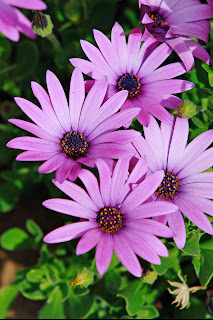Thursday, April 30, 2009
Monday, April 27, 2009
Saturday, April 25, 2009
Wednesday, April 22, 2009
Monday, April 20, 2009
Saturday, April 18, 2009
St John's wort
St John's wort used alone refers to the species Hypericum perforatum, also known as Tipton's Weed or Klamath weed, but, with qualifiers, is used to refer to any species of the genus Hypericum. Therefore, H. perforatum is sometimes called Common St John's wort to differentiate it. The species of Hypericum have been placed by some in the family Hypericaceae, but more recently have been included in the Clusiaceae. Approximately 370 species of the genus Hypericum exist worldwide with a native geographical distribution including temperate and subtropical regions of North America, Europe, Asia Minor, Russia, India, and China. St. John's wort is today most widely known as a herbal treatment for depression. According to the Cochrane Review, a key resource in evidence-based medicine, "the available evidence suggests that the hypericum extracts tested in the included trials are superior to placebo in patients with major depression; are similarly effective as standard antidepressants; and have fewer side effects than standard antidepressants.
Botanical description:St John's wort is a perennial plant with extensive, creeping rhizomes. Its stems are erect, branched in the upper section, and can grow to 1 m high. It has opposing, stalkless, narrow, oblong leaves which are 12 mm long or slightly larger. The leaves are yellow-green in color, with transparent dots throughout the tissue and occasionally with a few black dots on the lower surface. Its flowers measure up to 2.5 cm across, have five petals, and are colored bright yellow with conspicuous black dots. The flowers appear in broad cymes at the ends of the upper branches. The sepals are pointed, with glandular dots in the tissue. There are many stamens, which are united at the base into three bundles. Read more on this article...
Labels:
St John's wort
Friday, April 17, 2009
Siam Tulip
The Siam Tulip or Summer Tulip (Curcuma alismatifolia) is a tropical plant native to northern Thailand and Cambodia. Despite its name, it is not related to the tulip, but to the various ginger species such as turmeric. It can grow as an indoor plant, and is also sold as cut flowers.
One of the most famous wild fields of Siam Tulips is in the Pa Hin Ngam National Park in the Chaiyaphum province of Thailand.
Read more on this article...
Labels:
Siam Tulip
Wednesday, April 15, 2009
Shasta Daisy
The Shasta daisy (Leucanthemum x superbum) is a commonly grown herbaceous perennial plant with the classic daisy appearance of white petals (ray florets) around a yellow disc, similar to the Oxeye daisy Leucanthemum vulgare Lam. but larger. Formerly classified in the genus Chrysanthemum, these daisies were transferred to their own genus of Leucanthemum because they lack some traits of true Chrysanthemums. Shasta daisies are characterized by a distinct odor which some find unpleasant, which makes them unusual amongst flowers.
The Shasta Daisy originated as a hybrid produced by the famed horticulturist Luther Burbank, Leucanthemum lacustre (Brot.) Samp. x Leucanthemen maximum (Ramond) DC. Some members of the genus are considered noxious weeds, but the Shasta Daisy remains a favorite garden plant and groundcover.
Read more on this article...
Labels:
Shasta Daisy
Tuesday, April 14, 2009
Rudbeckia
Rudbeckia fulgida are perennial herbaceous plants growing up to 120 cm tall, growing from rosettes that develop at the end of stolons. Stems are glabrous or moderately covered in hirsute hairs with spreading branches. The leaves have blades that are lanceolate to broadly ovate or elliptic in shape with out lobes. The leaf bases are attenuate to cordate in shape and the margins of the leaves are usually entire or serrate, or sometimes lacerate. The upper surfaces of the leaves are glabrous or have hirsute to strigose hairs. The basal leaves are petiolate, with petioles that are 5 to 30 cm long and 1 to 8 cm wide, the cauline or stem leaves have petioles that are 2 to 25 cm long and 0.5 to 7 cm wide, the bases are attenuate to cordate or auriculate in shape.
The flower heads are often produced one per stem but are also often produced in corymbiform arrays with 2 to 7 flowers per stem. The cups that hold the flowers called receptacles, are hemispheric to ovoid in shape with paleae 2.5 to 4 mm long, the apices are obtuse to acute in shape with the ends usually glabrous and the apical margins ciliate. The flower heads have 10 to 15 ray florets with laminae elliptic to oblanceolate in shape and 15–25 cm long and 3 to 6 mm wide. The abaxially surfaces of the laminae have strigose hairs. The flower discs or center cones are 12 to 16 mm tall and 10 to 18 mm wide, made up of 50 to over 500 disc florets, with the corollas proximally yellowish green and brown-purple distally in color, 3 to 4.2 mm long, having style branches 1.3 mm long.
Read more on this article...
Labels:
Rudbeckia
Subscribe to:
Posts (Atom)



















































